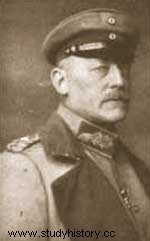
General Oskar von Hutier (August 27, 1857, December 5, 1934) was one of the best German generals, one of the most innovative during the First World War. In particular, he developed a tactic widely used by the Germans and which was applied to the Sturmtruppen, the German assault troops.
Hutier's tactic
Hutier spent the first year of the war as a divisional commander on the Western Front. He succeeded in his actions quite well but it was in 1915 that he distinguished himself, when he was transferred to the eastern front. There he became a corps commander attached to the German Tenth Army, and was instrumental in the conquest of large parts of Russia and Lithuania during the two years following his appointment to this new position. He became an army general in 1917 and Hutier began to apply the lessons learned from his three years of wars, with his study of the tactics employed by other armies. He devised a new strategy so that the Germans could finally break through to the French front. These tactics were to be successful in 1917 and 1918. The French called this strategy the "Tactic of Hutier", although the term generally used today is "the tactic of infiltration". von Hutier had noted that in many previous battles the conventional method was to launch an attack, with a prolonged barrage of all artillery following the line of a mass infantry assault. This strategy caused many losses. He suggested an alternative approach, now called the Hutier tactic or the infiltration tactic, which is composed of these basic steps:
1:A short artillery bombardment, featuring heavy shells mixed with lots of gas, these projectiles would focus on enemy lines to neutralize them, but not destroy them.
2:Under a creep barrage, German shock troops (the Sturmtruppen) would advance and infiltrate enemy defenses at previously identified weak points. They would avoid combat as much as possible and should attempt to destroy or capture enemy HQs or artillery positions.
3:After the assault units had done their job, the other German army units, heavily equipped with machine guns, and mortars would make powerful attacks along enemy strongpoints that the Stosstrupps had forgotten about. artillery was in place, the gunners could direct fire wherever it was needed to hasten the breakthrough.
4:In the final stage of the assault, the regular infantry would mop up any remaining Allied resistance. Many other generals had planned attacks along similar lines in the past, such as Army Colonel Emory Upton at the Battle of Spotsylvania in 1864. But Hutier was the first commander to use them on a large scale. and continue.
Oskar von Hutier's success began on September 3, 1917, when Hutier, commanding the German Eighth Army, captured the Russian city of Rīga after two years of siege and with his tactics. He used for this success an amphibious assault (the only successful one of the war) to seize the Russian-held islands in the Baltic Sea. Although Hutier was not present, other German generals used his methods in October 1917 to win a spectacular victory over the Italians at the Battle of Caporetto. Hutier was awarded the Medal of Merit by Kaiser Wilhelm II of Germany and transferred to the Western Front in 1918. In March of that year Hutier again used infiltration tactics in the Second Battle of the Marne and was hammered the Allied line along the gap between the French and English armies, advancing 40 miles along the Somme towards Amiens. The Germans took 50,000 prisoners and Hutier received the oak leaves in addition to his Medal of Merit.
Other achievements
Hutier's tactics were used in another major victory against the French in June 1918, but the allies had had time to build countermeasures to these methods. In July, when the Germans advanced further towards what would later be called the Second Battle of the Marne, the American and French armies had devised a defensive system set back from the front, which the exhausted German assault troops did not been able to cross.
Hutier, however, made a triumphant return to Germany after the end of the war. Like his cousin, General Erich Ludendorff, commander-in-chief of the German army, Hutier maintained that the German army had not been beaten on the battlefield but "hit in the back" by enemies from within.
He left the army in 1919 to become President of the League of German Officers, a post he held until his death on December 5, 1934.
